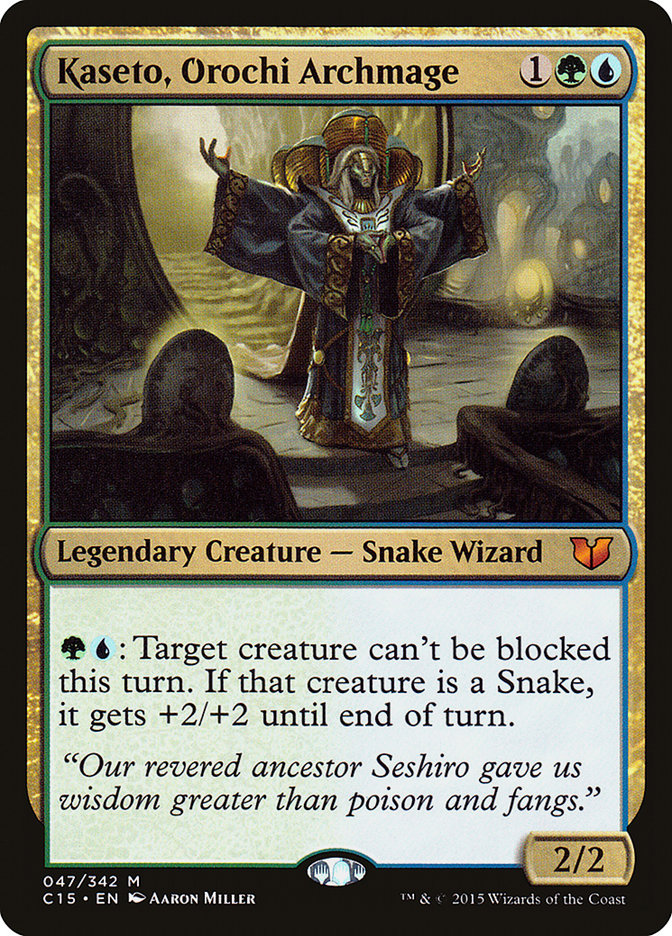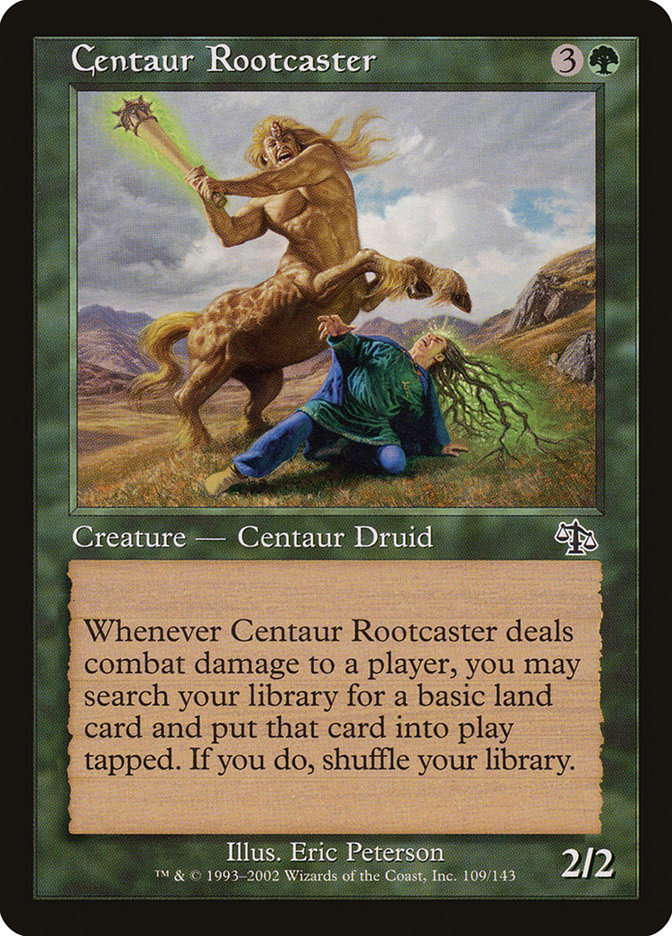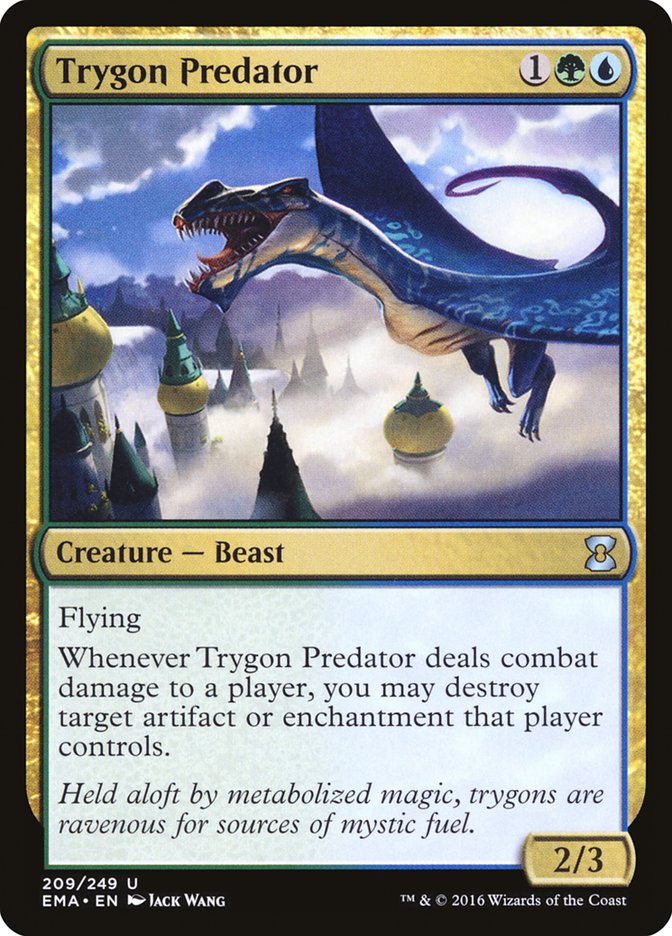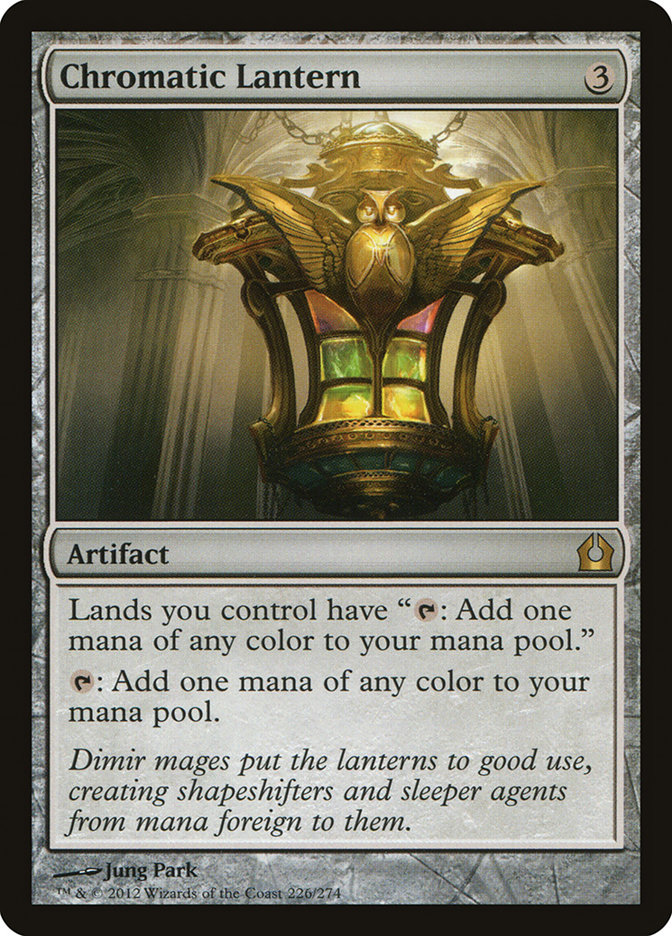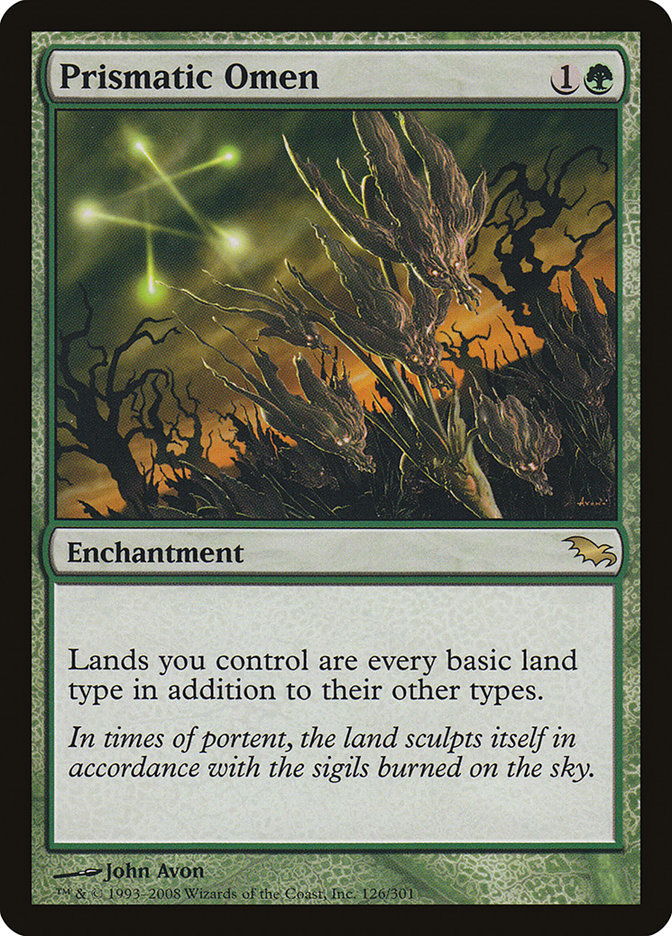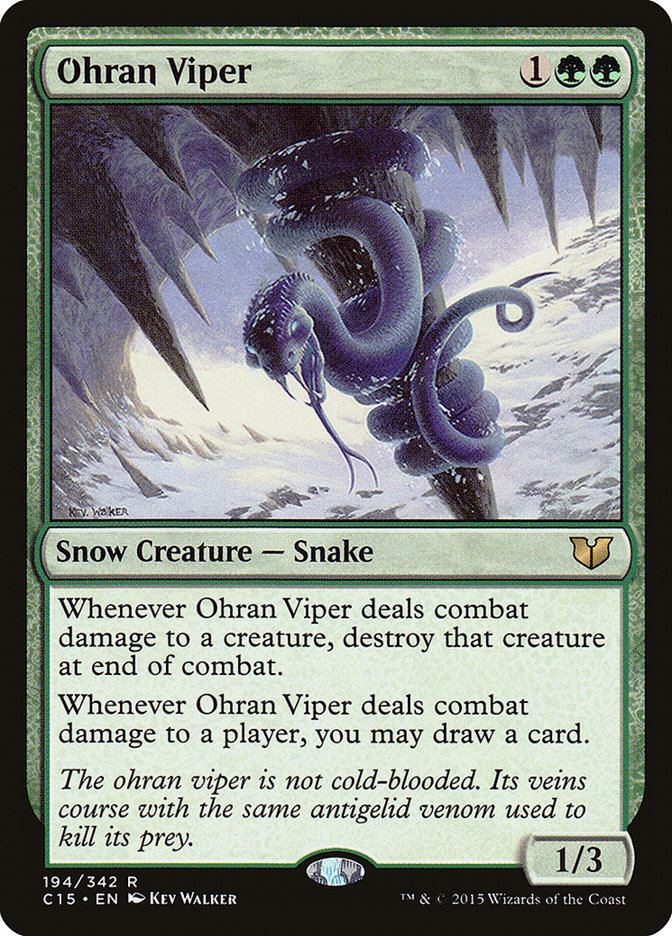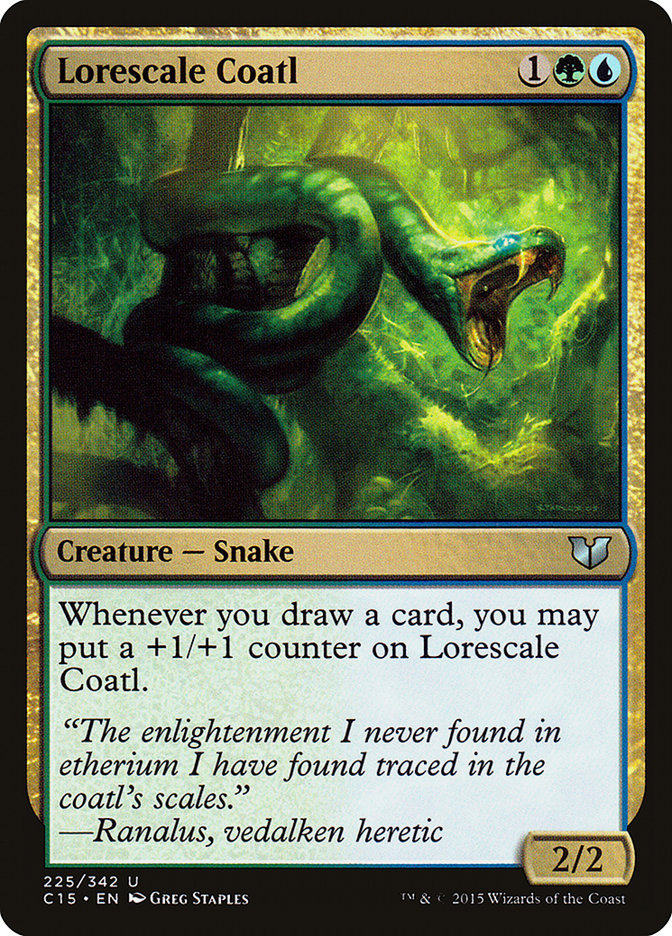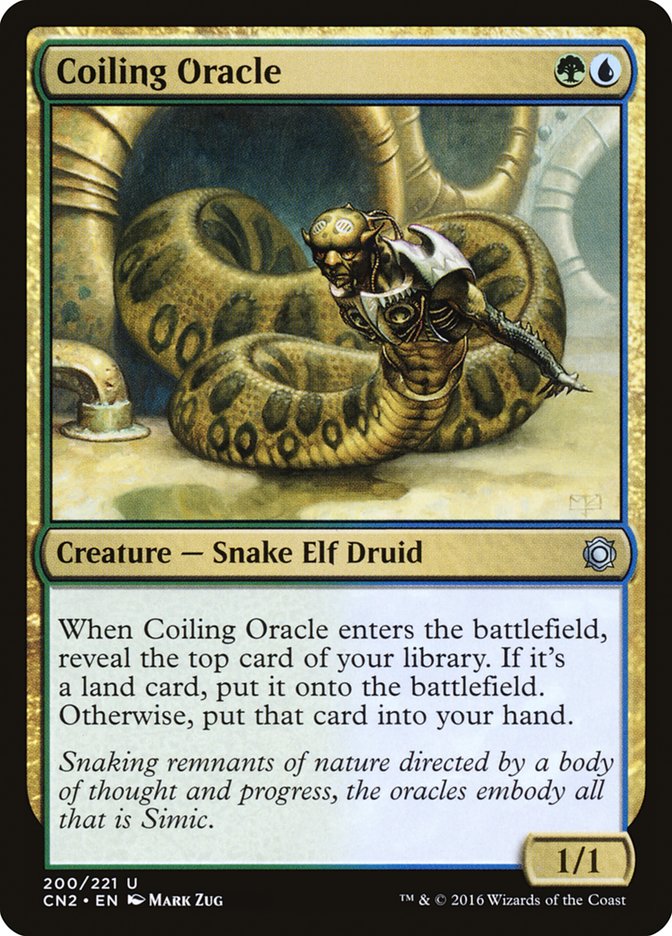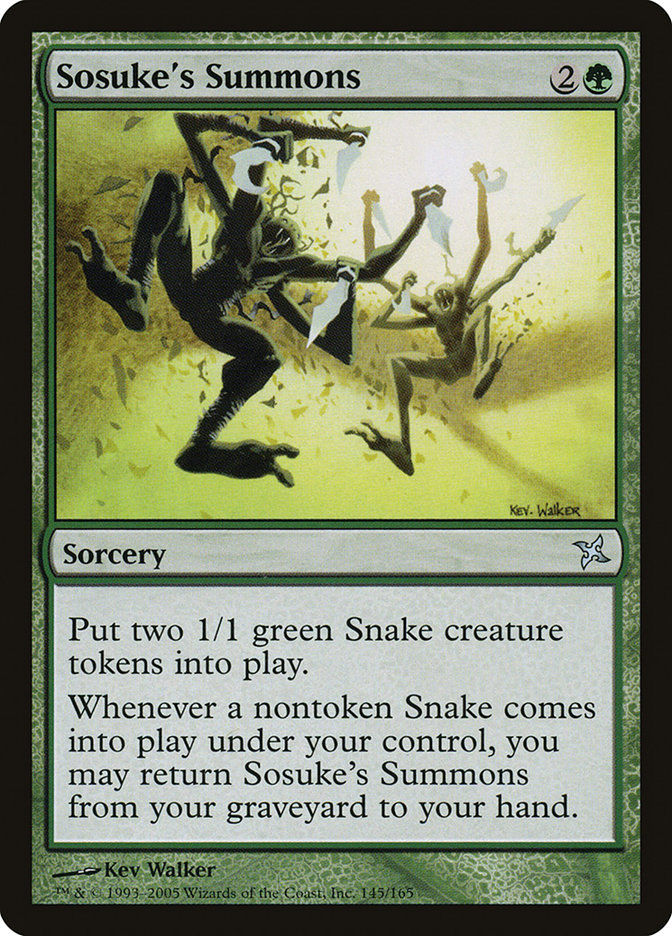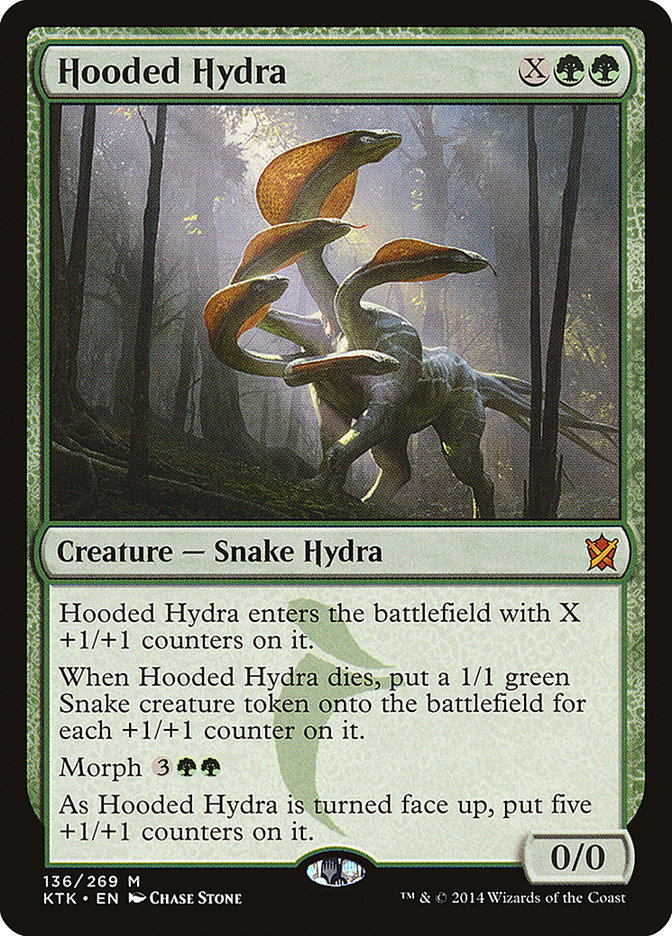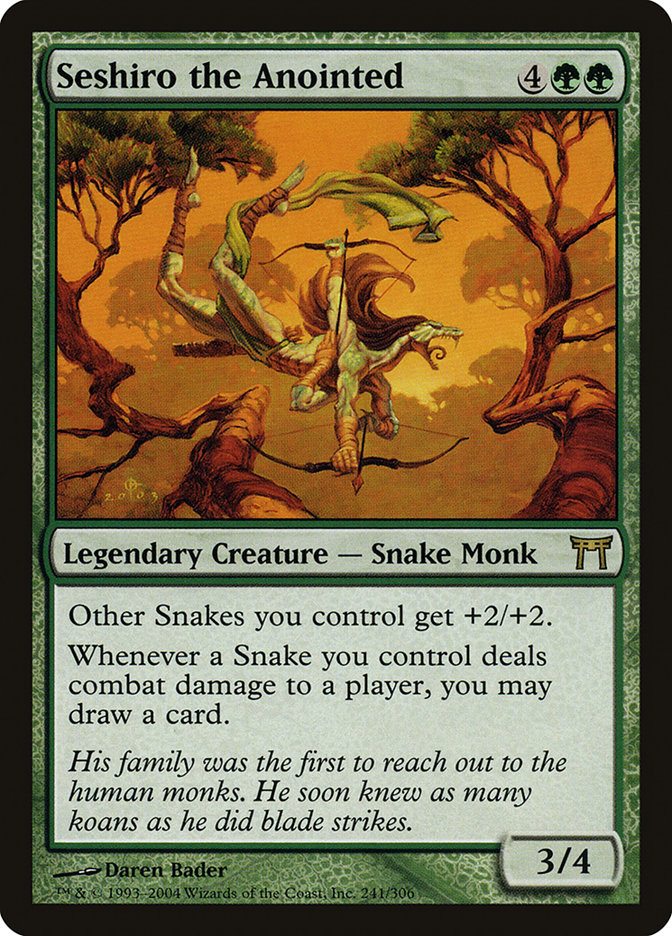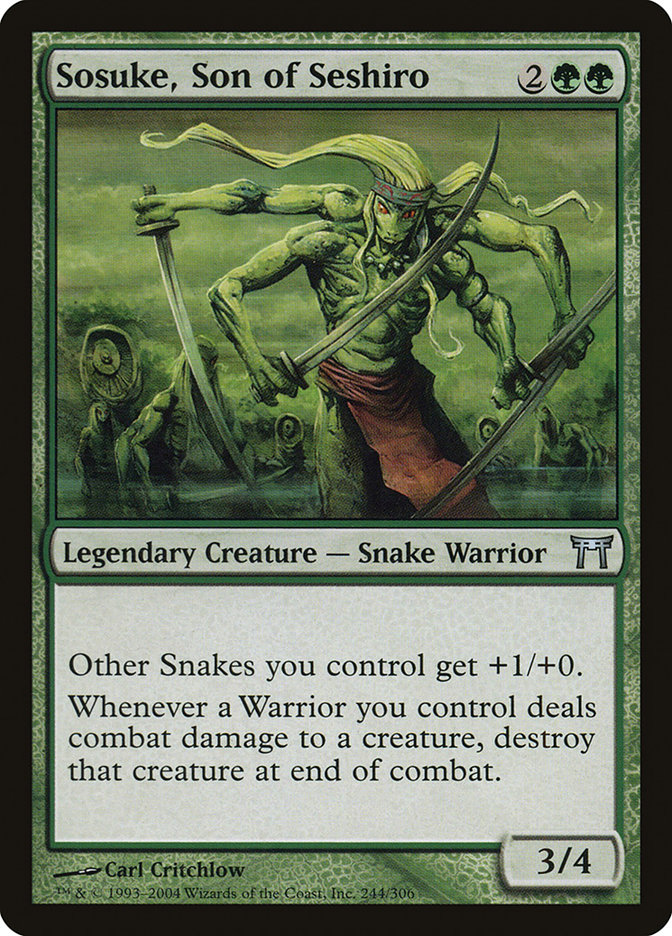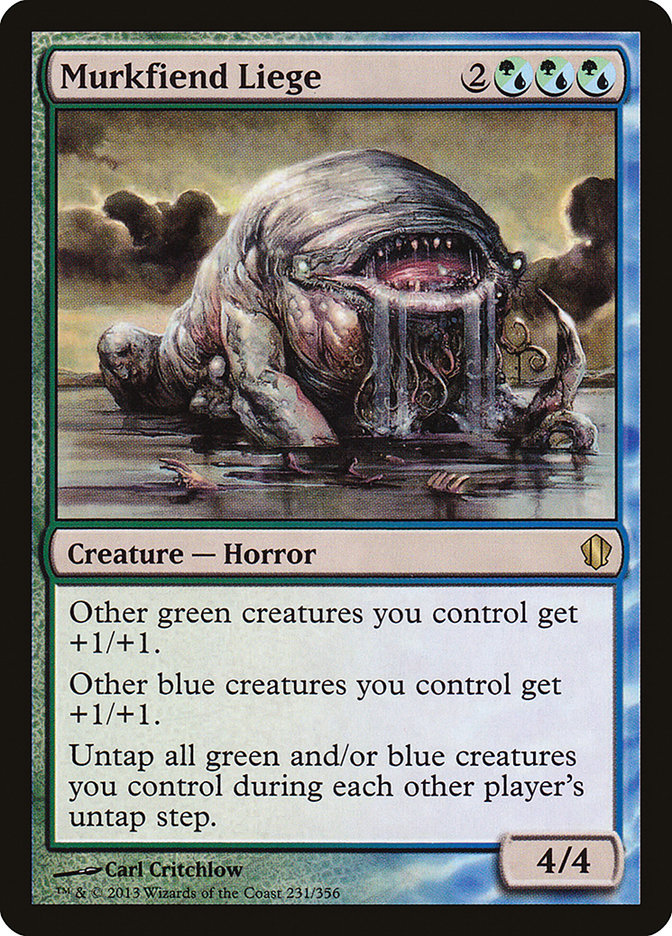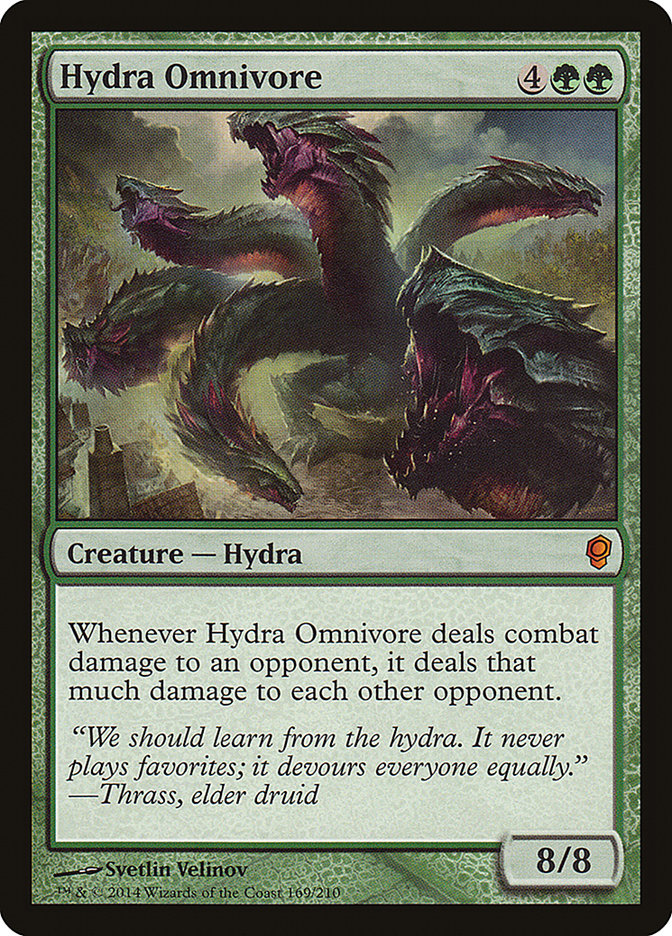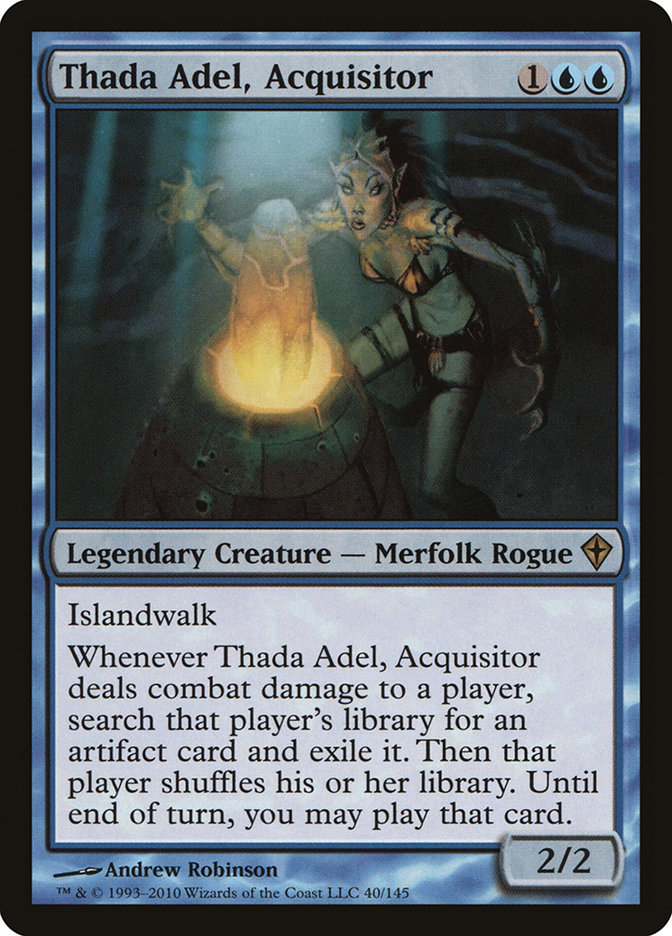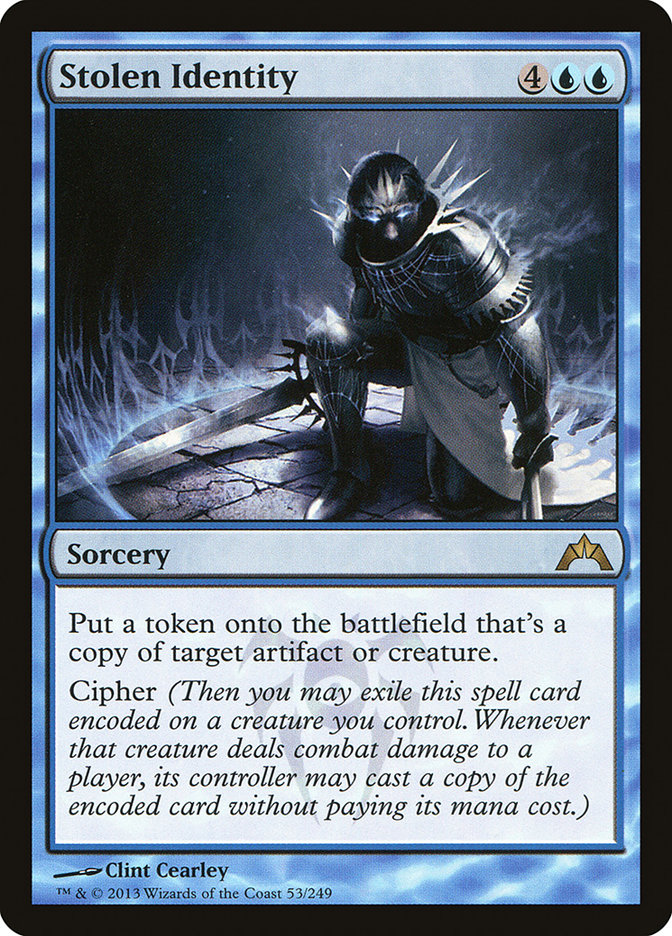Last week I talked about restricting your deck building options with Pauper Commander. Like Pauper, Tribal builds also restrict deckbuilding options and force you to get a little more creative. Tribal decks take a single creature type and push it to greatness. Rather than a thematic element or mechanical focus, the decks typically rely in synergies and cards that care about a specific creature type. Most often the decks are Goblins, Zombies, Elves, or Wizards. Other times you want to push the creativity and choose a less common tribe like Snakes.
I may have given away the surprise in the title…
When Kaseto, Orochi Archmage was spoiled, I knew I would make a Sneaky Snake deck where my creatures would be impossible to block. Kaseto’s effect to pump Snakes helps to up the deck’s damage potential, since most Snakes are smaller creatures that don’t impress players in Commander. The Snake focus would help me keep to a theme and Kaseto provides a good support role; while allowing the deck to function without him, the deck fires on all cylinders when he is active.
When Kaseto, Orochi Archmage is commanding a deck, it really wants three things: combat triggers, Snakes, and fat creatures. Combat triggers, for this purpose, are found on cards like Centaur Rootcaster, Stealer of Secrets, or Trygon Predator. With Kaseto’s help, the creature can slide past the opposition and ensure you get the triggered effects. Snakes are the most straightforward part of the deck, since Kaseto will help them be sneaky and he’ll provide a handy pump effect. Turning two-power creatures into beaters with four to six power is a solid way to take out opponents. Finally, fatties don’t require the pump effect Kaseto provides to Snakes. Six- or eight-power creatures deal damage just fine.
Of course, combining those three things is great. Changelings from Lorwyn can help to provide larger creatures that still count as Snakes, and creatures like Hydra Omnivore are huge and have an effect when they connect with an opponent.
I went with the tribal Snake plan, with a small mix of creatures with combat triggers to spice things up. I hadn’t built a real tribal deck for Commander and Kaseto provided a good excuse to make one.
Mana
The manabase is a huge hang-up for the deck. Snakes slant very heavily towards green. There are a handful of blue Snakes and just a few Snakes that are blue and green. This is a green-heavy deck. However, Kaseto, Orochi Archmage wants nearly equal amounts of blue and green mana to maximize his effect. This effect pulls the deck in two different directions and it can wreak havoc with your game if you are not prepared.
A good remedy to this is cards that allow your mana to be spent any way you need. Chromatic Lantern and Joiner Adept are two cards that help. Prismatic Omen is a great one, if you can afford it; this is one of the cards that Modern and Commander both want for very different reasons, so it carries a solid price.
However, running the cards to smooth out the mana for the deck helps illustrate another issue with Kaseto. When the deck is chugging along you are either developing your battlefield or developing damage against an opponent. But the mana requirements for Kaseto’s effect cost enough that getting through with a lot of damage won’t allow you to develop your battlefield further. This balance of developing your battlefield position versus damaging opponents has to be walked carefully.
Snakes!
When you pick a tribe, sometimes it greatly limits the power of your deck. With Elves and Zombies you have a great selection to find the best creatures, but selecting a less common or less humanoid tribe often gives you a pile of chaff and limited playable cards. Griffin Tribal led by Zuberi, Golden Feather might be a sweet deck, but it is still going to feature cards that haven’t seen the light of day since their format left Draft. Snakes are not too different from Griffins in this case; there is a lot of chaff in the collection of serpents available. Fortunately, the Snake tribe has many more gems than Griffins and some of the less common tribes.
Some highlights of these gems are cards like Ohran Viper and friends, Ophidian, and Broodbirth Viper. Drawing cards is always good. Drawing cards and getting some damage against opponents is very good. Drawing cards because your Snakes are sneaky? Now we’re cooking.
There are also good Snakes that are blue and green. Lorescale Coatl grows larger with every card drawn, if played early it can cause a lot of problems for your opponents. Played later, you can usually cast a follow up draw spell and start giving the Coatl a size boost immediately. Coiling Oracle is a gold standard two-drop: get a card or put a land onto the battlefield. It also blocks anything big and scary and can sneak past your opponents’ critters with a little pixie dust from Kaseto, Orochi Archmage.
Then there are tricky Snakes. It’s fun that there are sneaky Snakes and tricky Snakes. Winged Coatl is a tricky Snake. The card sometimes functions as a three-mana removal spell; other times it is another Snake cast with pseudo-haste (yay flash!) that Kaseto can pump as needed. Oh, Winged Coatl flies too. That’s a nice plus.
Then there are the little cards that make the deck hum. Sosuke’s Summons is often the second-most-important card in the deck, providing a small stream of tokens. The two Snakes add up, keeping up pressure on opponents or providing enough of a battlefield that they don’t have a profitable attack. When the recursion trigger is added to the mix, Sosuke’s Summons is an MVP card that doesn’t get enough respect. I will admit this is pretty nice, given that my graveyard has never been exiled when Sosuke’s Summons is in it.
For tribal decks, token generators are worth considering because they help generate a critical mass of creatures. I don’t own a Snake Basket, but it seems good. Orochi Hatchery is a card some players swear by; I could never get any value with it and I recently cut the card. But this tribe can be a little light on quality, and whenever you find yourself in that position, you should evaluate token generators before passing on them. One of the token producers, Hooded Hydra, has stood the test of time. Sometimes you just need tokens. Other times you just need a giant creature to attack. When Hooded Hydra dies, it leaves behind a nice little den of Snakes.
The Snake lords aid the den greatly. Sosuke, Son of Seshiro gives a little boost to power. There are not many Warrior creatures in the deck, but his effect helps him and the changelings that provide a few sizable bodies to the team.
Sachi, Daughter of Seshiro boosts toughness as a counterpoint to her brother. The second effect is excellent, and there are a handful of Shamans in the deck which can help cast spells. Seshiro, the Anointed One was the great Snake commander before Kaseto, Orochi Archmage came around. Seshiro boosts Snakes with a hefty +2/+2 and every Snake becomes a Stealer of Secrets. I love drawing cards because I attacked an opponent.
Kaseto works nicely with Seshiro; their two effects give a sneaky Snake +4/+4 and ensure that I can draw a card. The last lord is Murkfiend Liege. It boosts my green creatures, boosts my blue creatures, and does great work for my blue and green creatures. An effect that should not be overlooked is the untapping. It may only be creatures, but at the very least Murkfiend Liege provides a sort of vigilance and stops creatures from being tapped down for long.
Off-Tribe Creatures
Hydra Omnivore is the big baddie of the deck. A six-mana 8/8 is impressive, but dealing damage to each opponent for connecting in combat? That is a serious effect. Kaseto allows the Hydra Omnivore to sneak past the defenders and give every opponent a good whack for eight damage. Blade of Selves is a solid card, but the Hydra is honestly the reason I run it. I want to live the dream of attacking with a myriad Hydra Omnivore and activating Kasteo’s effect to ensure all the Hydra Omnivores connect. It might take six mana, but it is a story of legend: 24 damage to every opponent off combat and some triggers. After that, it won’t even matter that I become the archenemy. I’ll be too busy giggling to try to win.
Stealer of Secrets is a simple inclusion; I like drawing cards. Kaseto may not pump it up, but he can allow it to go unblocked. Stealer of Secrets complements the Ohran Viper family, helping me see some card advantage in most games. I like to believe Stealer of Secrets is an honorary Snake.
The utility combat creatures begin with Centaur Rootcaster, a Rampant Growth on legs. The initial down payment may be more, but with Kasteto it costs UG to Rampant Growth every time I attack. The deck is mana-hungry, so this non-Snake is a great boon to the sneaky slithering serpents. One with Nature is the enchantment version.
Another utility creature is Trygon Predator. Isn’t Lurking Predators annoying to face? Blow it up. Black Market out of hand? Blow it up. Swords of Value and Stuff causing issues? Blow them up. Trygon Predator sees occasional play in Eternal formats for a reason.
The utility creatures reach a peak with Thada Adel, Acquisitor and Prime Speaker Zegana. Thada Adel snags great artifacts from people. If you like Sol Ring, make sure you have Single Ladies cued up and ready to go. Beyoncé has your back. Your opponents always have something worth snagging. Even if you can’t cast it, you can exile a Blightsteel Colossus or another annoying card and prevent it from being used against you.
Prime Speaker Zegana helps the deck reload and has a respectable body to help push through damage. Zegana is even better if Changeling Titan is out.
Best of the Rest
The rest of the deck is stuff to get mana, draw some cards, answer some problems, and blow out opponents. Basically ramp, seasoned to taste. Card draw is focused in creatures but I run a few cards to help get a hand quickly when I run low on cards. The answers are mostly for artifacts and creatures. I rarely have an issue with creatures, since I can develop a solid battlefield. But Deglamer helps remove the Gods from Theros block, which are troublesome to remove. The Overrun effects are the classics and a little bland to discuss, but Tribal Unity is a fun card. Suddenly Snakes are gigantic and no longer need to be sneaky.
I also run a few Clone effects, like Rite of Replication and Stolen Identity. Rite of Replication allows me to recover in the late-game from something bad like Elesh Norn, Grand Cenobite. Sometimes you just need a bunch of Stormtide Leviathans to close out a game. Stolen Identity fits with the combat trigger portion of the deck. I can Clone creatures,and hopefully get a few more uses out of the spell with Cipher. Kaseto is never the cipher target. He draws enough hate and I do not want to make him a bigger target. But Ambush Viper? No one wants to lose the creature, and Kaseto can make sure it connects.
Creatures (36)
- 1 Sakura-Tribe Springcaller
- 1 Sakiko, Mother of Summer
- 1 Seshiro the Anointed
- 1 Ophidian
- 1 River Boa
- 1 Sosuke, Son of Seshiro
- 1 Shisato, Whispering Hunter
- 1 Sachi, Daughter of Seshiro
- 1 Orochi Sustainer
- 1 Orochi Eggwatcher
- 1 Mystic Snake
- 1 Centaur Rootcaster
- 1 Coiling Oracle
- 1 Patagia Viper
- 1 Trygon Predator
- 1 Ohran Viper
- 1 Glass Asp
- 1 Mire Boa
- 1 Changeling Titan
- 1 Chameleon Colossus
- 1 Game-Trail Changeling
- 1 Cold-Eyed Selkie
- 1 Murkfiend Liege
- 1 Lorescale Coatl
- 1 Winged Coatl
- 1 Lotus Cobra
- 1 Thada Adel, Acquisitor
- 1 Edric, Spymaster of Trest
- 1 Hydra Omnivore
- 1 Ambush Viper
- 1 Stealer of Secrets
- 1 Prime Speaker Zegana
- 1 Nessian Asp
- 1 Hooded Hydra
- 1 Skullwinder
- 1 Broodbirth Viper
Planeswalkers (1)
Lands (36)
Spells (26)
- 1 Sosuke's Summons
- 1 Overrun
- 1 Sol Ring
- 1 Regrowth
- 1 Whirlwind
- 1 Rampant Growth
- 1 One with Nature
- 1 Tribal Unity
- 1 Harrow
- 1 Simic Signet
- 1 Ponder
- 1 Deglamer
- 1 Cobra Trap
- 1 Rite of Replication
- 1 Nature's Claim
- 1 Jace's Ingenuity
- 1 Overwhelming Stampede
- 1 Chromatic Lantern
- 1 Illusionist's Bracers
- 1 Stolen Identity
- 1 Unexpected Results
- 1 Bident of Thassa
- 1 Commander's Sphere
- 1 Blade of Selves
- 1 Verdant Confluence
- 1 Thought Vessel

Chipping for Damage, or Opportunity Attacks
Many, many multiplayer games are won in the early-game. It takes a lot longer for the resolution, but the early damage matters far more than most give it credit for. Commander games are no different. Just because the format is known for haymakers does not mean we abandon all reason and start our curve on five mana.
Chip damage is the little incidental attack. Solemn Simulacrum is a good example of a creature that can be effective on offense. Few people want to trade a Guildmage or similar 2/2 creature in combat with a creature that gets value from entering and leaving the battlefield, so people will take the two damage rather than provide an opponent the extra draw. The pokes, prods, and small attacks that happen throughout the game are all part of the chipping. When someone has no blockers and you attack them for four damage, it’s chipping.
Getting in early damage helps you in a few ways. The first is to get blood in the water. Many players are like sharks; if they do not know where to attack, they will go where someone is weak. This is how at turn 4 one player will be at 25 life and everyone else is sitting pretty at 40. Someone took an early attack and the table all wanted to maximize value for their creatures. Getting in chip damage will send some opponents at each other. Their blind focus on life totals can be to your advantage.
The early small damage also works to maximize your big plays. In boxing or MMA (mixed martial arts), do the fighters immediately start with a haymaker punch or similar attack? No. They start with body blows, grapples, and other attacks and maneuvers that put them in a better position. Magic works the same way. The early moves build towards something. A fast opponent with good blocking won’t let the knockout punch hit. But if you beat up on his ribs for a bit to make him hurting and slow, that right hook is a lot more useful, since he can’t keep up and then you can dominate the fight.
You want to build towards something like a fighter, not just in deck construction but in play. Chipping away so that a big finish is guaranteed to be successful is a good plan. Going for broke with Overwhelming Stampede and having your remaining opponent untap and cast Wrath of God to remove your battlefield? Not a good plan. Sometimes it happens, but if you could have applied early pressure and damage and didn’t, that situation is your fault. Learn from it, and maximize your early attacks to get value later.
The best part about the little chip attacks is that many Commander players ignore them. We are so used to big devastating attacks that two or four damage seems like nothing. Two damage is only five percent of your life total. But five percent over three turns adds up, especially when there is a situation where trades and blocks aren’t profitable. We all take extra damage here and there to ensure we can have a good counterattack. That moment, after not registering the chip damage, is how you end up in the twenties and everyone is above thirty life.
With the chip damage, you are always doing something, but not enough to be noticed. Humans are generally bad at tracking small accumulations: climate change, debt, coffee spending, etc. Use this to your advantage for some early bits of damage.
Game Plan
My sneaky Snakes often deal a finishing blow in a crushing attack of slithering sneaky serpents. But that is only possible because I used the art of chipping at opponents to win with a collection of mostly two-powered creatures. Kaseto’s unblockable ability ensures that I can connect for two to four damage, depending on the creature’s type. This little damage seems like nothing. But Chameleon Colossus is a lot better at getting to 32 damage than 40.
The Snakes only hit for five to ten percent of a life total, and I typically keep it that way. Blasting away with six- and eight-power Snakes can take out a player quickly, but it uses up all of my mana and leaves me vulnerable to my other opponents. Instead, I keep the attacks smaller so that I do not need to commit as much to them. Since I am almost never trading in combat on attacks, my opponents can build up battlefield position. I need smaller attacks to have enough defense that attacking me opens them up to another opponent. Deathtouch Snakes help in both sides of this. No one really wants to block Ambush Viper or Ohran Viper. They also don’t particularly want to attack into them.
To Sum It Up
Only after chipping away with my sneaky Snakes do I go for the Overwhelming Stampede or Overrun plays. The deck is more about body blows and less about haymakers. Chipping maximizes the power of a late-game massive attack and protects you from serious counterattacks. I build the Snake deck to chip and chip and chip before making a power play to take down players. The games I win with this deck often end with me taking out two or three players at once, since everyone is chipped down and attacking each other through their own threat assessment that I can supersize something and use an Overrun effect to finish the table.
How about you? Do you chip away at opponents or wait for the alpha strike? Am I missing some spectacular Snake card? Or are you like Dr. Jones and hate Snakes?


